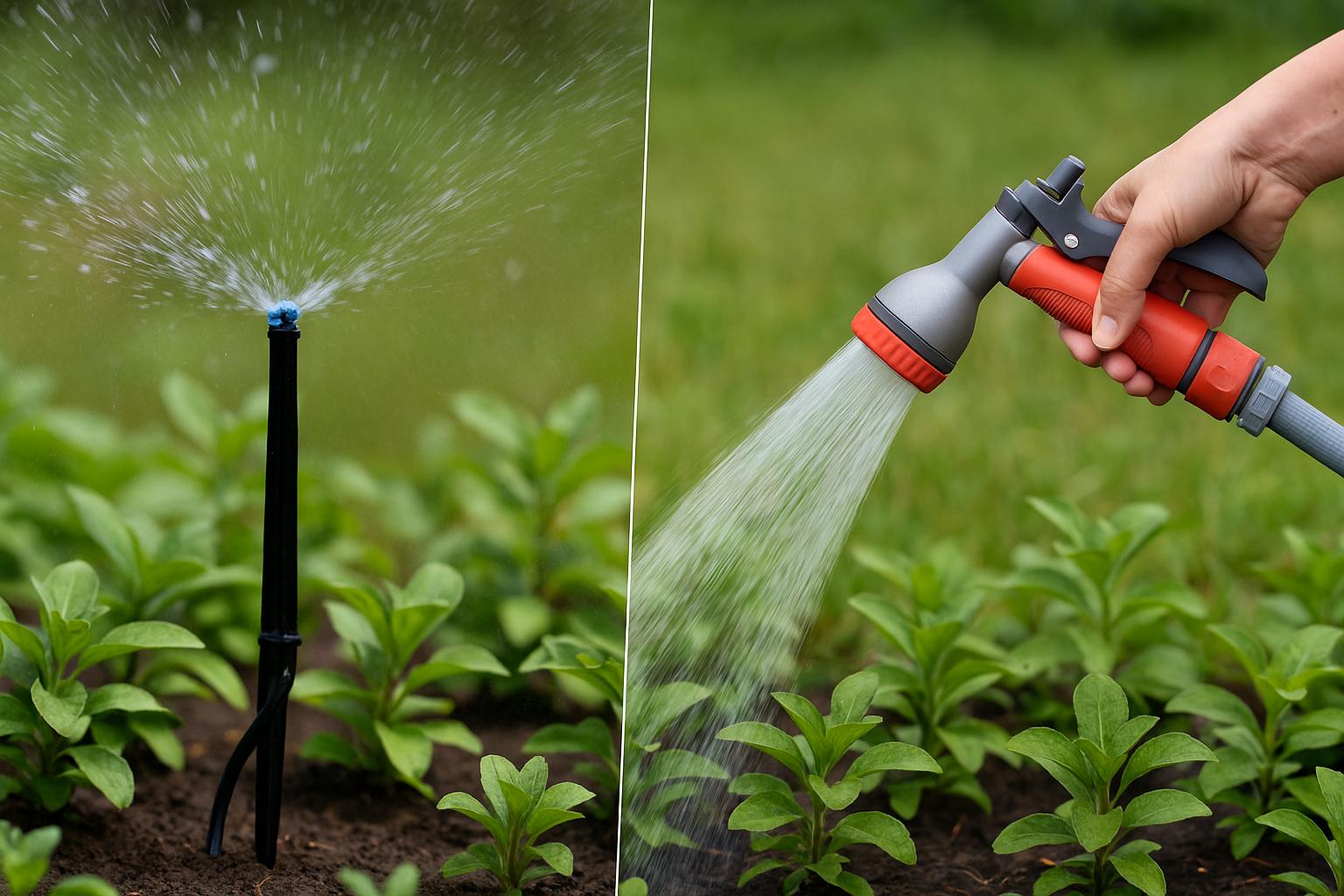The debate between spray pumps and hand watering is far from new, but in recent years, agricultural research has given us far more clarity on how each method impacts plants, water efficiency, and crop health. Whether you’re tending a small urban garden or managing a commercial farm, the way you deliver water to plants plays a significant role in yield, disease prevention, and long-term soil quality. Understanding the science behind both approaches can help you make better decisions for your crops, time, and resources.
Why the Method of Water Delivery Is More Important Than You May Think
Water affects plant stress levels, soil microbial health, and nutrient delivery in addition to hydration. Plants interact with the way water is given rather than just reacting to it as a liquid source. For instance, whereas deep but infrequent watering helps roots to penetrate deeper into the soil for moisture, regular light watering may foster shallow root systems.
Agricultural studies suggest that the wrong delivery method can lead to:
- Excessive evaporation and water loss.
- Higher rates of fungal diseases caused by prolonged leaf wetness.
The method you choose affects water use efficiency (WUE), which, according to the Food and Agriculture Organization (FAO), is a major factor in sustainable farming practices, especially as global water scarcity concerns rise.
Spray Pumps: Precision, Pressure, and Productivity
Spray pumps work by atomizing water into fine droplets and distributing it evenly over a large surface. They can be handheld, backpack-style, or mounted on tractors, depending on the scale of the operation. One of their key advantages is the ability to mix fertilizers or pesticides directly into the water, delivering them uniformly to plant surfaces.
Water contact is usually more consistent when plants are sprayed than when they are watered by hand. Because of this accuracy, there is a lower chance of overwatering some areas while drying others. Furthermore, spray pumps are ideal for large-scale agriculture, as they can significantly reduce labour time, according to research published in the Journal of Irrigation and Drainage Systems.
However, environmental factors and calibration have a significant impact on the efficiency of spray pumps. Spray drift can result in uneven coverage or even harm to non-target plants if it is used under windy conditions.
Instead of employing a one-size-fits-all strategy, producers may now select from a greater variety of nozzles and capacities thanks to the possibility to shop Spray Pumps online in various farming setups.
Hand Watering: Control and Connection
Despite its simplicity, hand watering provides an unparalleled degree of control. The size of the plant, the moisture content of the soil, and the growth of the roots can all affect the flow. Gardeners and farmers can identify early indicators of stress, pests, or nutritional deficiencies by using this technique, which promotes more thorough plant monitoring.
For sensitive seedlings, potted plants, or locations where precise water distribution is required, hand watering is frequently recommended. According to a University of California Cooperative Extension study, because growers can adjust to minute daily variations, meticulous human watering can lower plant fatality rates for several high-value crops when compared to automated systems.
Yet, hand watering is time-intensive and may be inconsistent when multiple people are involved. It also risks higher overall water use, as humans tend to overcompensate when visually judging how much water a plant needs.
Water Distribution Patterns and Plant Response
Water flows differently through soil and plant tissue depending on how it is applied, according to plant physiology. Depending on droplet size, spray pumps may soak foliage more thoroughly than soil, which is advantageous for foliar feeding but can be detrimental to the spread of fungi in humid conditions. In contrast, hand watering frequently concentrates water at the base of plants, reducing leaf wetness but perhaps causing uneven soil moisture zones if not done consistently.
The influence of water droplets is also important, according to studies from the American Society of Agricultural and Biological Engineers. While too light hand watering may not reach root zones, high-pressure sprays can compress soil surfaces, decreasing penetration rates. Because of this, both strategies need to be used carefully.
The Science of Evapotranspiration and Water Loss
The combined loss of water from plant transpiration and soil evaporation is known as evapotranspiration (ET). ET rates are influenced by the watering technique you use. Spray pumps can reduce direct evaporation losses, particularly when used during the cooler morning or evening hours. However, irrigation research from the University of Nebraska–Lincoln shows that light misting on hot, windy afternoons can cause up to 40% of water to be wasted before it even reaches the soil.
If water is administered directly to the soil, hand watering can reduce evaporation losses; however, it is often slower, allowing for more exposure time for evaporation in hotter climates.
Energy, Labor, and Cost Considerations
For larger-scale enterprises, spray pumps typically provide higher returns from an economic perspective because they require less labor and can be used for both pest control and nutrient application simultaneously. However, if labour expenses are minimal for small gardens, the initial investment in high-quality spray pumps might not be warranted.
Hand watering takes a lot of time but requires little equipment. Particularly in regions with metered water systems, even minor inefficiencies in water application over the course of a season can result in considerable increases in water bills.
“In farming, efficiency is not about doing less—it’s about doing the right things, in the right way, at the right time.”
Environmental Impact of Irrigation Methods
One of the main pillars of sustainable agriculture is now water conservation. In many situations, properly calibrated spray pumps can use less water than hand watering, particularly when combined with integrated pest management. However, manual watering is less harmful to nearby ecosystems since it can prevent spray spread and non-target effects.
Understanding the local climate, soil composition, and crop needs is crucial for farmers seeking to increase sustainability, rather than relying solely on equipment type. To help farmers assess water efficiency for their specific circumstances, the USDA Natural Resources Conservation Service provides comprehensive tools and calculators.
Choosing the Right Method for Your Crops
Some crops respond better to one method over the other. For example:
- Spray pumps are often favored for crops like lettuce or brassicas that benefit from foliar feeding.
- Hand watering is better for root vegetables or young seedlings, where soil moisture control is critical.
Climate should also be taken into consideration; arid places may prefer spray pumps for their rapid application and even coverage, while humid regions may find them more dangerous for the spread of illness.
FAQs
- Which method is more water-efficient?
It depends on how they’re used. Spray pumps can be more efficient for large areas if calibrated properly, while hand watering can be more effective for small, targeted areas. - Does spray pumping cause plant diseases?
Only if used improperly, especially in humid environments where wet foliage encourages fungal growth. Timing and droplet size are key. - Can I combine both methods?
Yes. Many growers use spray pumps for large-scale coverage and hand watering for delicate plants or problem spots. - Is one method better for fertilizers?
Spray pumps are ideal for foliar feeding, while hand watering is better for slow-release soil amendments.
Beyond the Comparison
In actuality, there is more than one option when it comes to hand watering versus spray pumps. Depending on crop stages, pest pressures, and seasonal variations, the majority of prosperous growers combine both. The science demonstrates the advantages and disadvantages of each technique, but the optimal irrigation plan is dynamic and changes with the plants. Mastering both tools and determining when each would work best for your crops is the true expertise, not choosing one over the other.


